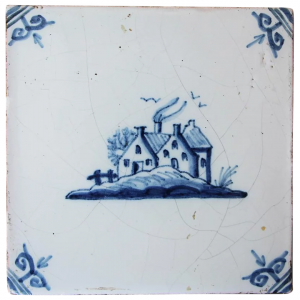Enamelled Hearth
Object

The object is a piece of enamelled hearth, which is part of the collections at Beamish Museum. It consists of a rectangular strip of iron which had been coated in vitreous enamel on the top and bottom surface.
The enamel on the top surface had been applied in a way to mimic the appearance of blue ceramic tiles and the white area in the centre with the transfer appears to mimic a delftware type tile. This central area shows an image of a valley with a river and cottage. There is a female figure beside the cottage and a male figure approaching the house with two horses.

Such rural designs were popular from the eighteenth century and are found in the paintings of artists such as Constable and Wilson. These rural domestic subjects are also found on Delftware tiles and it maybe that this design is related to Delftware items considering that the enamel has been applied to mimic ceramic tiles. Similar transfers are found on other enameled objects and were popular until the 1920s although they were most commonly used during the nineteenth century.
Condition
- There is evidence of a layer of dust and dirt on the surface.
- There is an iron stain on the right side of the hearth.
- Several scratches on the surfaced of the enamel
- Evidence of surface material loss of the enamel
- The exposed iron surface shows signs of corrosion.
Conservation

The upper surface was brushed with a stiff brush to remove any loose dust, dirt and rust fragments. The surface was then cleaned with cotton wool swabs and a solution of 50:50 deionised water / ethanol. This removed a large amount of dirt from the surface and greatly improved its visual appearance.

The areas of enamel loss, which showed the corroded iron surface, were treated with wire wool to produce a smooth surface and were then cleaned with ethanol to remove all dirt and grease and ensure maximum surface contact between the metal and Jenolite. Jenolite was applied to the corroded areas in order to help stabilise the iron and prevent further corrosion.
The treated metal was then coated with three layers of 8% Paraloid B72 in acetone which will also help to protect the treated metal, secure the loose edges of enamel and help to ensure the reversibility of the inpainting.

Trylon casting resin was used to replace the missing metal with a layer of fine fibre glass which was cut bigger than the missing metal and placed over the area to be filled. The casting resin was applied to the fibreglass with a pipette over a section of aluminium foil which was used as a mould. The resin was left overnight to cure and the aluminium foil was removed. A filler of sodium carboxymethylcellulose and Paraloid B72 was then applied to the surface of the coated metal and allowed to cure for two hours. Humbrol enamel paints were mixed and painted onto the filled areas of metal and allowed to dry.
